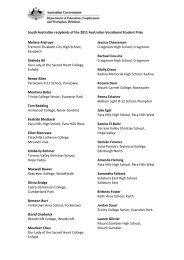Belonging, Being and Becoming - Early Years Learning Framework
Belonging, Being and Becoming - Early Years Learning Framework
Belonging, Being and Becoming - Early Years Learning Framework
You also want an ePaper? Increase the reach of your titles
YUMPU automatically turns print PDFs into web optimized ePapers that Google loves.
BECOMING<br />
BECOMING<br />
LEARNING LEARNING OUTCOMES<br />
OUTCOMES<br />
BELONGING<br />
BELONGING<br />
Children Children have have a a strong strong sense sense of of identity identity<br />
Children are Children connected participate with <strong>and</strong> in contribute communities to their world<br />
Children Children have have a a strong strong sense sense of of wellbeing wellbeing<br />
Children Children are are confident confident <strong>and</strong> <strong>and</strong> involved involved learners learners<br />
Children Children are are effective effective communicators<br />
communicators<br />
CURRICULUM<br />
CHILDREN’S<br />
DECISION<br />
MAKING LEARNING FOR<br />
CHILDREN’S<br />
LEARNING<br />
Secure, Secure relationships respectful <strong>and</strong> <strong>and</strong> reciprocal positive relationships interactions<br />
Genuine Partnerships partnerships with with families<br />
High Respect expectations for diversity <strong>and</strong> equity<br />
Community Respect for to diversity equity<br />
Ongoing learning Reflective <strong>and</strong> practice reflective practice<br />
10 BELONGING, BEING & BECOMING The <strong>Early</strong> <strong>Years</strong> <strong>Learning</strong> <strong>Framework</strong> for Australia<br />
PRINCIPLES<br />
PRINCIPLES<br />
PEDAGOGICAL PRACTICE PRACTICE<br />
Holistic approaches Play-based curriculum <strong>and</strong> intentional <strong>Learning</strong> teaching environments<br />
Responsiveness to Physical children <strong>and</strong> social learning environments Cultural competence<br />
<strong>Learning</strong> through Continuity play of learning Continuity <strong>and</strong> transitions of learning <strong>and</strong> transitions<br />
Intentional teaching Assessment for learning Assessment for learning<br />
Figure 1: Elements of the <strong>Early</strong> <strong>Years</strong> <strong>Learning</strong> <strong>Framework</strong><br />
Involvement:<br />
is a state of intense, whole hearted<br />
mental activity, characterised by sustained<br />
concentration <strong>and</strong> intrinsic motivation.<br />
Highly involved children (<strong>and</strong> adults)<br />
operate at the limit of their capacities,<br />
leading to changed ways of responding<br />
<strong>and</strong> underst<strong>and</strong>ing leading to deep level<br />
learning. (adapted from Laevers 1994)<br />
BEING<br />
BEING<br />
Dispositions:<br />
enduring habits of mind <strong>and</strong> actions, <strong>and</strong><br />
tendencies to respond in characteristic<br />
ways to situations, for example,<br />
maintaining an optimistic outlook, being<br />
willing to persevere, approaching new<br />
experiences with confi dence. (Carr, 2001)





